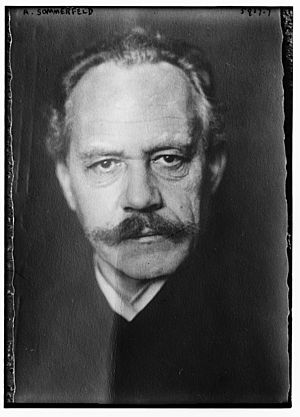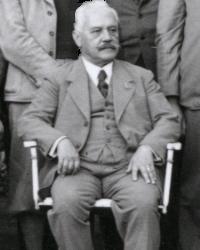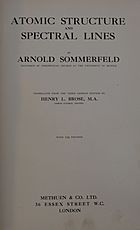Arnold Sommerfeld facts for kids
Quick facts for kids
Arnold Sommerfeld
|
|
|---|---|

Sommerfeld in 1897
|
|
| Born |
Arnold Johannes Wilhelm Sommerfeld
5 December 1868 |
| Died | 26 April 1951 (aged 82) |
| Alma mater | University of Königsberg |
| Known for |
|
| Awards |
|
| Scientific career | |
| Fields | Physics |
| Institutions |
|
| Thesis | The arbitrary functions in mathematical physics (1891) |
| Doctoral advisor | Ferdinand von Lindemann |
| Doctoral students |
|
| Other notable students |
|
| Influenced | John Bardeen Léon Brillouin |
Arnold Johannes Wilhelm Sommerfeld (born December 5, 1868 – died April 26, 1951) was a German theoretical physicist. He was a leader in developing atomic and quantum physics. He also taught and guided many students who became important scientists.
Sommerfeld was a doctoral supervisor for many future Nobel Prize winners in physics and chemistry. Only J. J. Thomson mentored a similar number of future Nobel laureates. Sommerfeld introduced important concepts like the second and third quantum numbers. He also came up with the fine-structure constant and helped develop X-ray wave theory.
Contents
Early Life and School
Arnold Sommerfeld was born in 1868 in Königsberg, Prussia. His family had lived in Prussia for a long time. His father, Franz Sommerfeld, was a doctor. His mother, Cäcilie Matthias, was the daughter of a builder. Arnold was baptized as a Christian and kept his faith, even though he wasn't very religious.
He studied math and science at the Albertina University in his hometown. His main teacher was the mathematician Ferdinand von Lindemann. He also learned from other famous mathematicians like David Hilbert and physicists like Emil Wiechert. He earned his Ph.D. on October 24, 1891, when he was 22.
After getting his doctorate, Sommerfeld stayed at Königsberg to get his teaching diploma. He passed his exams in 1892. Then, he spent a year in the military. He continued to do voluntary military service for eight more years. With his mustache and strong build, he looked like a military officer.
His Career in Physics
Starting in Göttingen
In October 1893, Sommerfeld moved to the University of Göttingen. This university was a major center for mathematics in Germany. He became an assistant to Theodor Liebisch at the Mineralogical Institute. Liebisch had been a professor at Königsberg and knew Sommerfeld's family.
In 1894, Sommerfeld started working as an assistant to Felix Klein, a very famous mathematician. Sommerfeld helped Klein with his lectures and managed the math reading room. In 1895, Sommerfeld completed his Habilitationsschrift under Klein. This allowed him to become a private lecturer (called a Privatdozent) at Göttingen. He taught many topics in math and physics.
Klein and Sommerfeld worked together for 13 years (1897–1910) on a four-volume book called Die Theorie des Kreisels (The Theory of the Gyroscope). This book covered the theory of rotating objects and their uses in areas like earth science and astronomy. Working with Klein helped Sommerfeld focus on applied mathematics and become a great lecturer.
While in Göttingen, Sommerfeld met Johanna Höpfner, whose father was a university official. In 1897, Sommerfeld got a job as a math professor at the Bergakademie in Clausthal-Zellerfeld. This job paid well enough for him to marry Johanna.
Moving to Aachen
In 1900, Sommerfeld became a professor of Applied Mechanics at the Königliche Technische Hochschule Aachen (now RWTH Aachen University). Here, he developed theories about how liquids and gases move. This topic interested him for a long time. Later, his students at the University of Munich, Ludwig Hopf and Werner Heisenberg, wrote their Ph.D. papers on this subject.
Years in Munich
From 1906, Sommerfeld became a full professor of physics and director of the new Theoretical Physics Institute at the University of Munich. He was chosen by Wilhelm Röntgen, who discovered X-rays. Sommerfeld saw this as a great opportunity.
In the early 1900s, theoretical physics became very important in Germany. Scientists like Sommerfeld and Max Born (at the University of Göttingen) helped make this happen. They showed that mathematical physics could lead the way, with experiments confirming their ideas. Many of Sommerfeld's students, including Wolfgang Pauli, Werner Heisenberg, and Walter Heitler, went on to make huge contributions to quantum mechanics.
Sommerfeld taught at Munich for 32 years. He gave many courses, from general physics to specialized topics based on his research. He also held seminars where students presented papers. From 1942 to 1951, he organized his lecture notes into a six-volume series called Lectures on Theoretical Physics.
Sommerfeld was an amazing teacher. Four of his doctoral students—Werner Heisenberg, Wolfgang Pauli, Peter Debye, and Hans Bethe—won Nobel Prizes. Many other students became famous scientists. Three of his postdoctoral students, Linus Pauling, Isidor I. Rabi, and Max von Laue, also won Nobel Prizes.
Albert Einstein once told Sommerfeld, "What I especially admire about you is that you have, as it were, pounded out of the soil such a large number of young talents." Sommerfeld was friendly with his students and colleagues. He encouraged them to work together, and their ideas often influenced his own. He even invited them to his home and to his alpine ski hut to discuss physics.
While in Munich, Sommerfeld learned about Albert Einstein's special theory of relativity. This theory was not yet widely accepted. Sommerfeld's mathematical work helped more scientists accept it. In 1914, he worked with Léon Brillouin on how electromagnetic waves travel.
He was also one of the founders of quantum mechanics. Some of his key contributions include:
- Co-discovering the Sommerfeld–Wilson quantization rules in 1915. This was a way to improve Bohr's atomic model.
- Introducing the Sommerfeld fine-structure constant in 1916.
- Co-discovering the Sommerfeld–Kossel displacement law with Walther Kossel in 1919.
- Publishing Atombau und Spektrallinien (Atomic Structure and Spectral Lines) in 1919. This book became very important for a new generation of physicists studying atomic and quantum physics.
In 1918, Sommerfeld became the head of the Deutsche Physikalische Gesellschaft (DPG), a German physics society. He helped start a new journal called Zeitschrift für Physik in 1920. This journal published new research quickly, which helped speed up the development of quantum mechanics in Germany.
In 1927, Sommerfeld used Fermi–Dirac statistics to improve the Drude model of electrons in metals. This new theory, called the Drude–Sommerfeld model, helped solve problems with predicting how metals behave with heat.
Sommerfeld was a brilliant theoretician. Besides quantum theory, he worked on other areas like the classical theory of electromagnetism. For example, he found a solution for how radio waves spread over the Earth. His Sommerfeld identity and Sommerfeld integrals are still used today to solve these kinds of problems. By 1928, almost one-third of all theoretical physics professors in German-speaking countries had been Sommerfeld's students.
On April 1, 1935, Sommerfeld retired. However, he continued to work temporarily while the university looked for his replacement. This process took a long time, until December 1, 1939. There were disagreements between the university and the government's education ministry. The government wanted to appoint Wilhelm Müller, who was not a theoretical physicist and had not published in physics journals. Many scientists, including Ludwig Prandtl and Carl Ramsauer, felt this appointment was harmful to physics education.
Sommerfeld, who was once very patriotic, wrote to Einstein after Hitler came to power. He said he was so upset by the misuse of the word "national" that he would be happy to see Germany become part of a peaceful Europe.
Sommerfeld received many awards during his life, including the Lorentz Medal, the Max-Planck Medal, and the Oersted Medal. He was elected to prestigious groups like the Royal Society of London and the United States National Academy of Sciences. He also received many honorary degrees from universities. He was nominated for the Nobel Prize 84 times, more than any other physicist, but he never won the award.
Arnold Sommerfeld died on April 26, 1951, in Munich. He was injured in a traffic accident while walking with his grandchildren. He is buried in the Nordfriedhof cemetery.
In 2004, the center for theoretical physics at the University of Munich was named after him.
Works
Articles
- Arnold Sommerfeld, "Mathematische Theorie der Diffraction" (The Mathematical Theory of Diffraction), Math. Ann. 47(2–3), pp. 317–374. (1896). .
- Arnold Sommerfeld, "Uber die Ausbreitung der Wellen in der Drahtlosen Telegraphie" (The Propagation of Waves in Wireless Telegraphy), Ann. Physik [4] 28, 665 (1909); 62, 95 (1920); 81, 1135 (1926).
- Arnold Sommerfeld, "Some Reminiscences of My Teaching Career", American Journal of Physics Volume 17, Number 5, 315–316 (1949).
Books
- Arnold Sommerfeld, Atombau und Spektrallinien (Atomic Structure and Spectral Lines) (Friedrich Vieweg und Sohn, Braunschweig, 1919)
- Translated by Henry L. Brose Atomic Structure and Spectral Lines (Methuen, 1923)
- Arnold Sommerfeld, Three Lectures on Atomic Physics (London: Methuen, 1926)
- Arnold Sommerfeld, Atombau und Spektrallinien, Wellenmechanischer Ergänzungband (Vieweg, Braunschweig, 1929)
- Translated by Henry L. Brose Wave-Mechanics: Supplementary Volume to Atomic Structure and Spectral Lines (Dutton, 1929)
- Arnold Sommerfeld, Lectures on Wave Mechanics Delivered before the Calcutta University (Calcutta University, 1929)
- Arnold Sommerfeld and Hans Bethe, Elektronentheorie der Metalle (Electron Theory of Metals), in H. Geiger and K. Scheel, editors Handbuch der Physik Volume 24, Part 2, 333–622 (Springer, 1933).
- Arnold Sommerfeld, Mechanik – Vorlesungen über theoretische Physik Band 1 (Mechanics – Lectures on Theoretical Physics Volume 1) (Akademische Verlagsgesellschaft Becker & Erler, 1943)
- Arnold Sommerfeld, Mechanik der deformierbaren Medien – Vorlesungen über theoretische Physik Band 2 (Mechanics of Deformable Bodies – Lectures on Theoretical Physics Volume 2) (Akademische Verlagsgesellschaft Becker & Erler, 1945)
- Arnold Sommerfeld, Elektrodynamik – Vorlesungen über theoretische Physik Band 3 (Electrodynamics – Lectures on Theoretical Physics Volume 3) (Klemm Verlag, Erscheinungsort, 1948)
- Arnold Sommerfeld, Optik – Vorlesungen über theoretische Physik Band 4 (Optics – Lectures on Theoretical Physics Volume 4) (Dieterich'sche Verlagsbuchhandlung, 1950)
- Arnold Sommerfeld, Thermodynamik und Statistik – Vorlesungen über theoretische Physik Band 5 (Thermodynamics and Statistics – Lectures on Theoretical Physics Volume 5) Herausgegeben von Fritz Bopp und Josef Meixner. (Diederich sche Verlagsbuchhandlung, 1952)
- Arnold Sommerfeld, Partielle Differentialgleichungen der Physik – Vorlesungen über theoretische Physik Band 6 (Partial Differential Equations in Physics – Lectures on Theoretical Physics Volume 6) (Dieterich'sche Verlagsbuchhandlung, 1947)
- Felix Klein and Arnold Sommerfeld, Über die Theorie des Kreisels [4 volumes] (On the Theory of the Gyroscope) (Teubner, 1897)
See Also
 In Spanish: Arnold Sommerfeld para niños
In Spanish: Arnold Sommerfeld para niños
- List of things named after Arnold Sommerfeld




